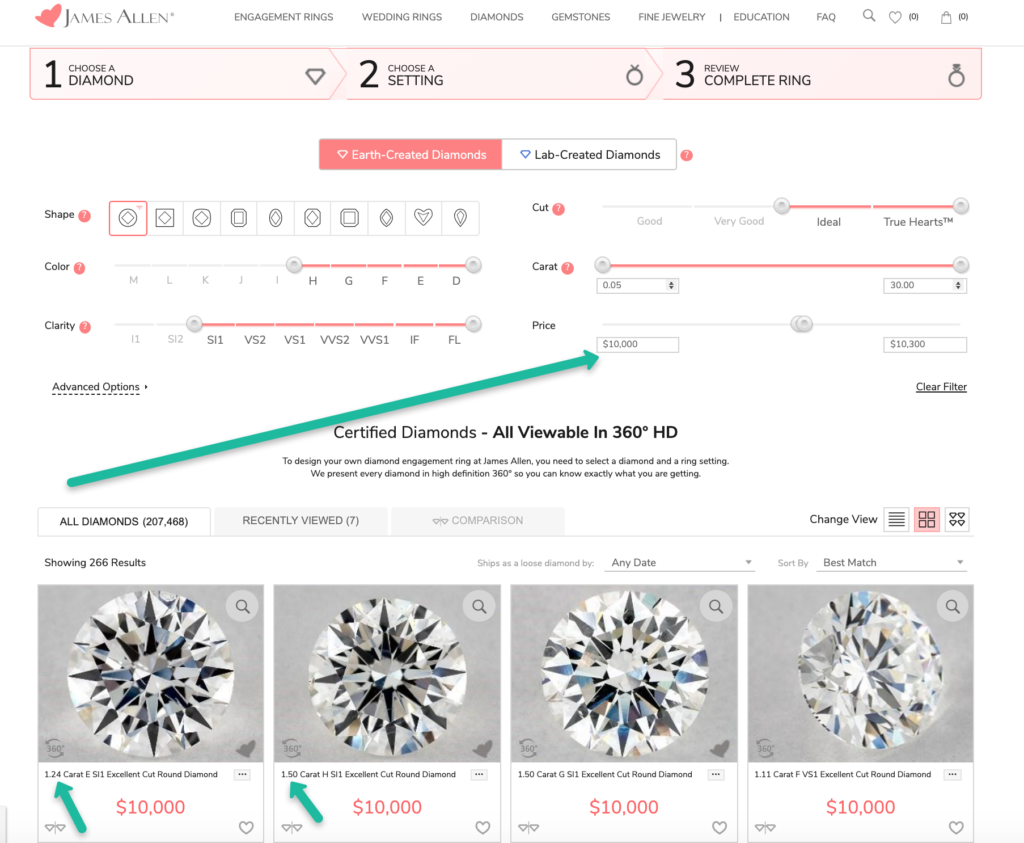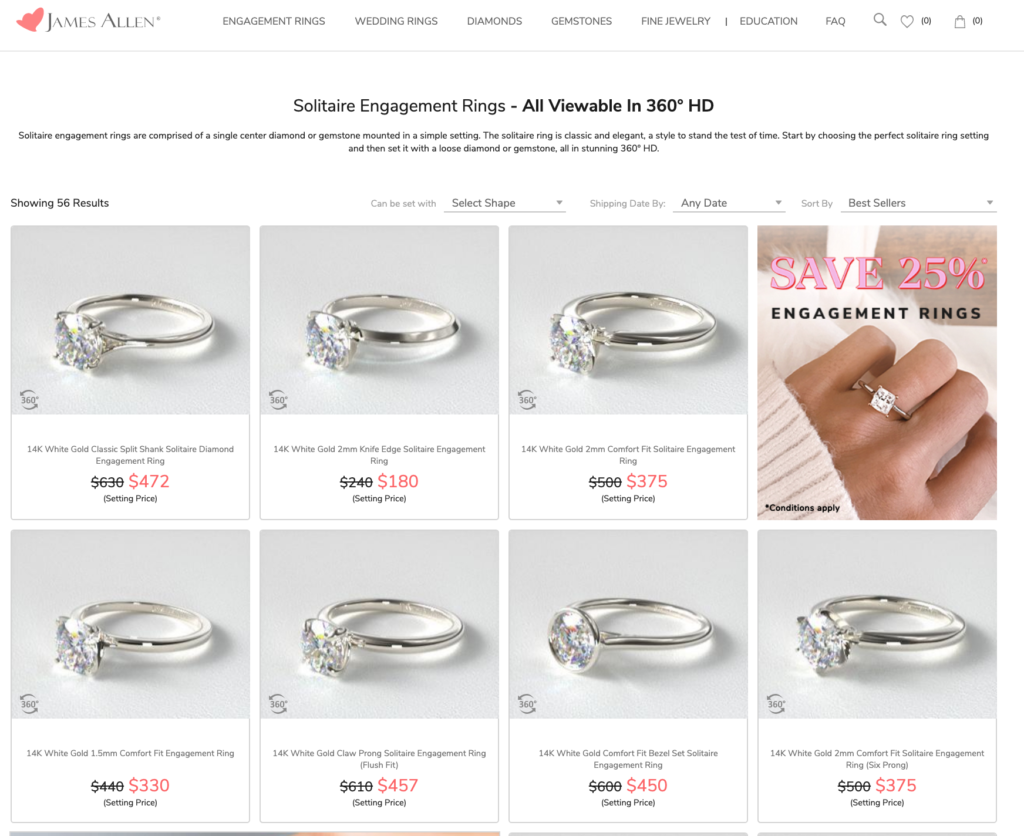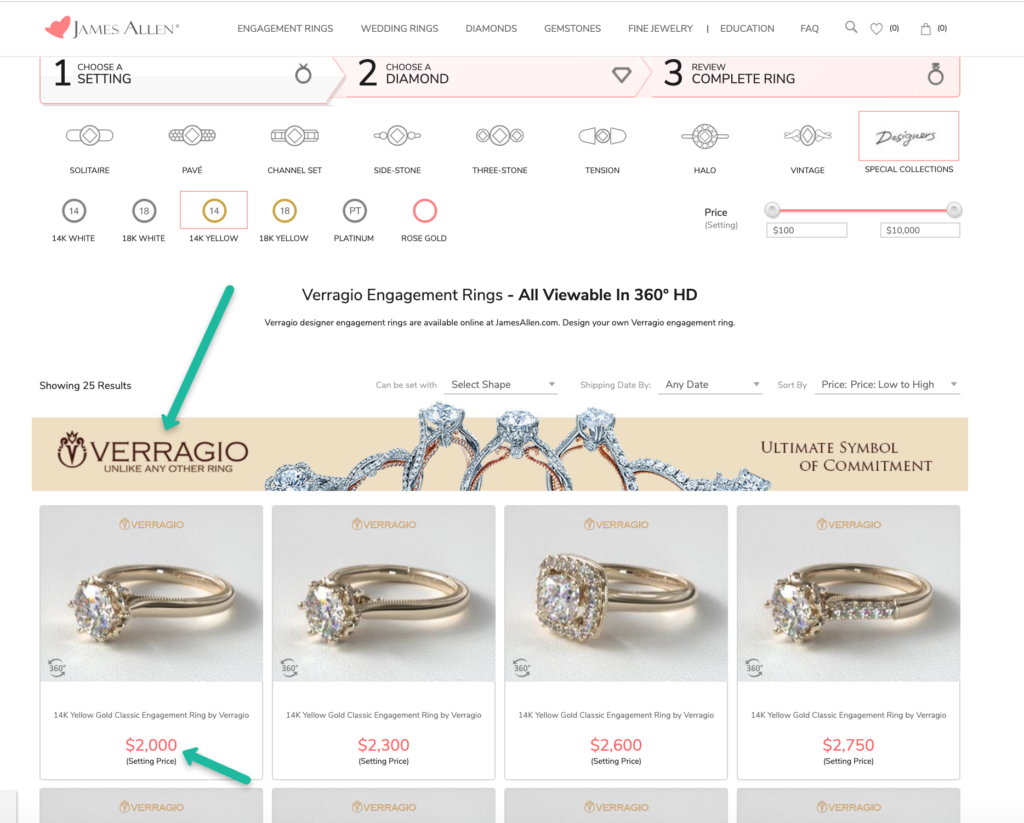Diamond Buying Guide: Learn How to Buy a Diamond Online
Welcome to Diamond Buying School’s comprehensive diamond buying guide. I’m glad you’re here (and I think you will be, too).
Note: You may want to bookmark this page or send yourself the link in a text or e-mail. This guide is designed to be used over the whole course of your journey buying a diamond — you may want to refer to it later.
Buying a diamond is a momentous decision — whether it’s your first time or 50th.
A diamond is a rare and valuable thing. You want to buy with confidence.
But equally as important is the fact that each gem, like the love it represents, is truly one-of-a-kind.
This diamond buying guide will first cover the basics of how diamonds are priced and what you need to know about diamonds before you begin shopping. Then, we’ll go over the process of shopping for your diamond step-by-step — whether you buy your stone from one of several reputable online diamond jewelers or a brick-and-mortar jewelry store.
And don’t worry, throughout this guide we will point out all the information to avoid running into scams or sketchy diamond merchants.
It’s true; there are diamond dealers who will try to take advantage of naive customers. At the same time, it’s easy to avoid being ripped off. You just need to understand the basics and to be sure to buy from trusted sources. Which is exactly why I wrote this diamond buying guide.
Guide to how diamonds are priced
Diamond prices are a function of supply and demand. Rough diamonds are more plentiful than you might think. But the diamond industry controls the rate at which diamonds are mined and cut to keep jewel-quality diamonds relatively rare in the marketplace.
Is this a bit conniving? Perhaps. But, you must admit it’s an ingenious business plan.
Also, consider the alternative. If diamonds were cheap, we’d have to find another perfectly symbolic, perfectly beautiful gift to demonstrate a pledge of eternal love. A gift that our partners could wear on their fingers. That was 300 billion years old. That was indestructible. Frankly, it’s hard to imagine what could accomplish that better than a diamond.
At the end of the day, it makes sense that diamonds are relatively rare in the marketplace.
And, fortunately, there are beautiful diamonds for sale that will meet virtually every budget.
The four C’s
A diamond’s value is based upon four criteria known as the four C’s: Carat, cut, clarity, and color.
These are legitimate pricing variables that control the value of diamonds worldwide. (Later, you’ll learn of some illegitimate pricing variables to watch out for.)
A diamond’s 4 C’s are graded by independent third-party gemology labs. The three major ones are the Gemological Institute of America (GIA), the International Gemological Institute (IGI) and the American Gemological Society (AGS).
Carat
Let’s start with carats — the quality most buyer’s notice and understand.
A carat is a unit of weight.
Diamonds are extremely dense. Consequently, a diamond’s carat weight translates, essentially, into size. The more a diamond weighs, the larger it is.
All else being equal, the larger the diamond, the more expensive it will be.
Clarity
The clearer a diamond, the better, more desirable and more expensive.
Virtually all diamonds have some “inclusions”, or small flaws.
These inclusions are usually gray or black specs. They can also be areas of feathering or cloudiness on the inside of the stone.
Any inclusion is considered an imperfection in the stone and, therefore, reduces the clarity of the diamond.
Color
Most diamond buyers want “white” (transparent) diamonds. In relation to these clear diamonds, “color” refers to a diamond’s degree of transparency, or how colorless it is.
Nearly all white diamonds have some amount of yellowish color, even if extremely slight. The more yellowish color in the stone, the less desirable it is, and so the less expensive.
Diamonds also come in different colors. Colored diamonds are referred to as “fancy diamonds”. Most color fancy diamonds are generally less expensive than “white” diamonds, but no less beautiful.
But fancy blue and fancy red diamonds are extremely rare and expensive.
Cut
Cut is the least well-understood quality by first-time diamond shoppers. Interestingly, cut is also the most important quality for determining a diamond’s price.
This is important: Cut in the context of “the 4 C’s” does not mean the diamond’s shape (e.g., round, princess, cushion, heart, etc.). It means the cut quality.
Cut quality is how well the diamond craftsperson executed the cut when creating the jewel from rough diamond.
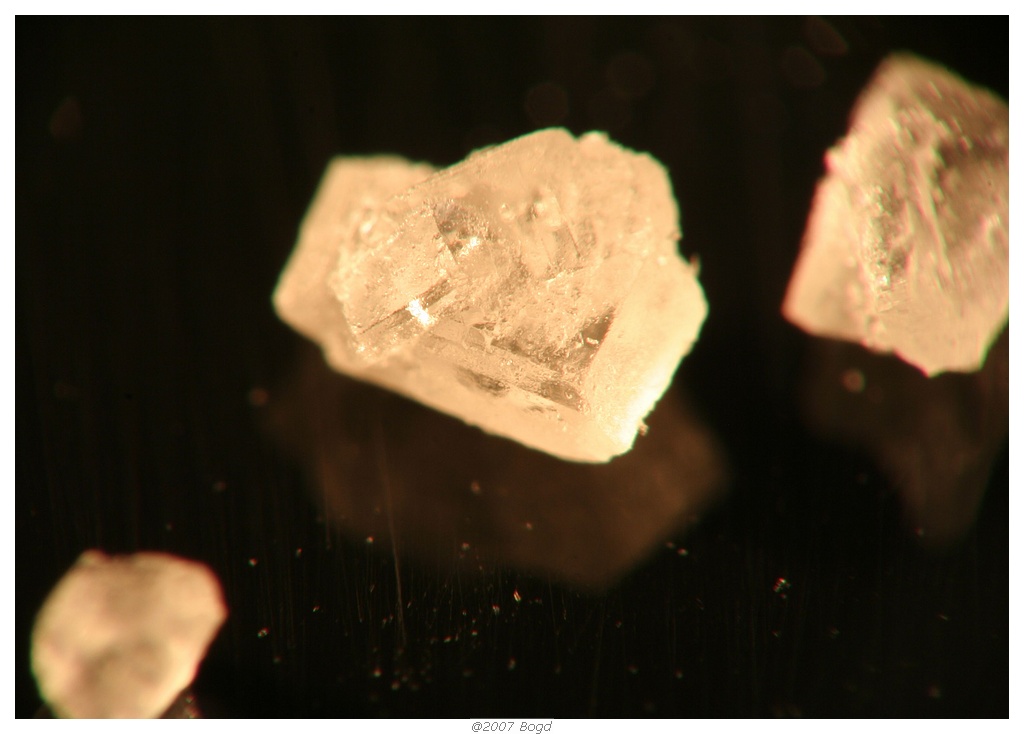
Diamonds look like plain rocks when they come out of the mine. Skilled diamond cutters strike the diamond along planes of cleavage to shape it. This takes skill (and also luck). Diamonds that come out completely proportional, symmetrical, and shaped in a way that maximizes their fire, sparkle and brilliance, are said to be well cut.
There are five grades of cut quality, according to the GIA, which is the most authoritative gemological lab in the world. They are Poor, Fair, Good, Very Good, and Excellent.
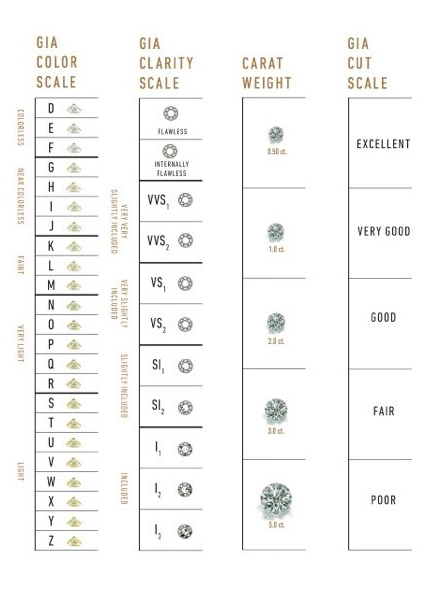
Do diamond prices change over time?
Not much! So, if you see a diamond marked “70% off,” don’t believe it.
Now, this isn’t to say trusted jewelers don’t have sales. You might find a diamond ring on sale for 5%, 10%, or — if you get really lucky — 25% off.
If somebody is pushing a diamond aggressively, the price was probably marked up to begin with. Either that, or something even fishier is going on.
If you hear “diamond prices are going to rise,” or “fall”, don’t believe it. They’re not.
The diamond industry doles out diamonds to the market at a rate that keeps diamonds stable in price. If demand shrinks, they slow down the entry of new diamonds into the market. If demand rises, they speed it up some.
Diamonds are not like cars. A jeweler rarely has leftover diamond inventory that they “have to move”. Remember, the diamond industry controls supply!
Are diamonds a good investment?
Diamonds are many things: rare, beautiful and valuable. But diamonds are not good investments.
If a salesperson (or a sales webpage) recommends a diamond as a “good investment,” don’t believe it. It’s absolutely not.
Diamonds are far more expensive retail than if you sold them on a secondary market. And no diamond retailer will buy it back for very much.
Why is this? Well, just think about it. Would you buy a diamond from some random person? Unless you’re an expert gemologist who can independently value a diamond on the spot, probably not. And, if you did, you probably wouldn’t pay very much for it…just in case.
Jewelers know that if you, as a consumer, is trying to sell a diamond, your only option is to sell back “into the industry”. Therefore, they can offer you much less than you originally paid to buy back the diamond.
It’s no different than if you couldn’t sell your used car on the open market. Rather, you could only trade your used car in to a dealership. The fewer your options, the worse deal you’re going to get as a seller.
The bottom line is that a diamond, like a car, depreciates the moment you take it home. Sure, it will always have value. A diamond will always be worth something. If you were to turn around and sell it, however, you might find that it’s worth between 25 and 50 percent less than you paid for it.
What kind of diamond can you get for $3,000?
In general, for $3,000, you can get a 0.7 to 0.75 carat internally flawless round brilliant cut diamond of excellent cut, but with G Color.
For the same amount of money, you can also buy about a one-carat princess or cushion cut of similar quality.
If you’re new to the diamond world, you might be saying “uh, what?” No worries. We’re going to explain everything.
To check this out for yourself, this page on JamesAllen.com shows you all diamonds in this price range.
You’ll see that I’ve preset the sliders, using the link, to round shape and limited the price slider to from $3,000 to $3,100.
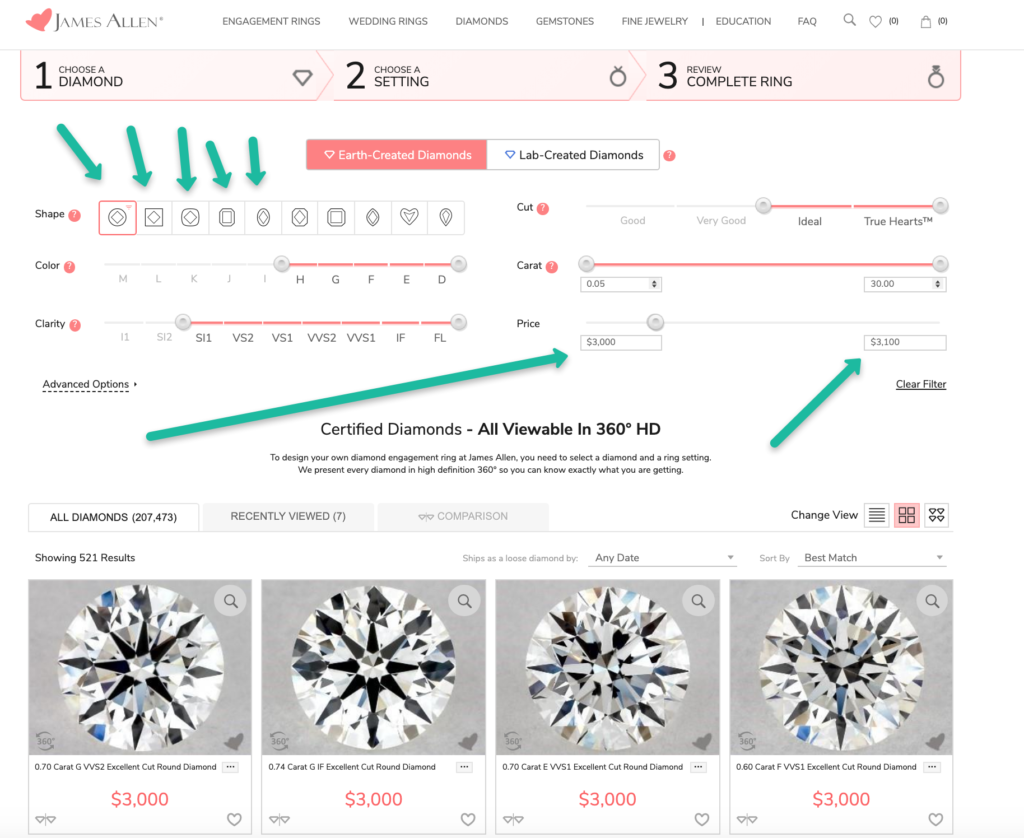
What kind of diamond can you get for $5,000? Or $10,000?
To see the kind of diamonds you can get for $5K or $10K, try moving the sliders at James Allen, for example.
Adjust the price range fields yourself or start by using these links:
$5,000 diamonds: You get about the same quality round brilliant as the $3,000 diamond except it’s going to be about 1-carat in size.
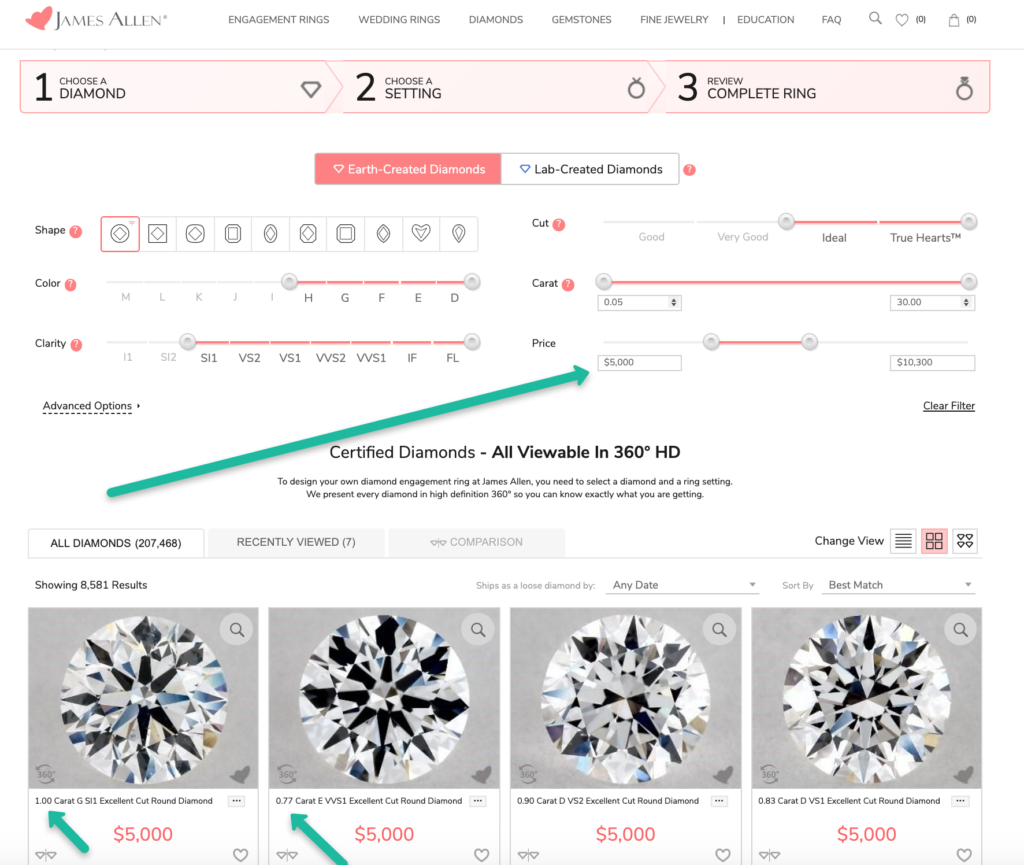
$10,000 diamonds: You get about the same quality round brilliant as the $3,000 one, but it’s going to be around 1.25 to 1.5 carats.
How much do engagement ring settings cost?
A ring setting (the metal ring it self and prongs to hold the gem) is relatively inexpensive when compared to the jewels it will hold. The lowest priced setting at James Allen is $240. At the time of publication, it was on sale for $180.
That’s for a 14K Gold (a common choice, because it’s excellent) knife-edge solitaire engagement ring setting.
Designer settings, even at James Allen, might be a heftier $2,000, if it’s a Verragio. (Depending on your preferences, that money might be better spent on a bigger or better diamond.)
Other designer rings at James Allen start at $740. To see all name designer collections at James Allen, scroll down until you see Designer Collections at this page.
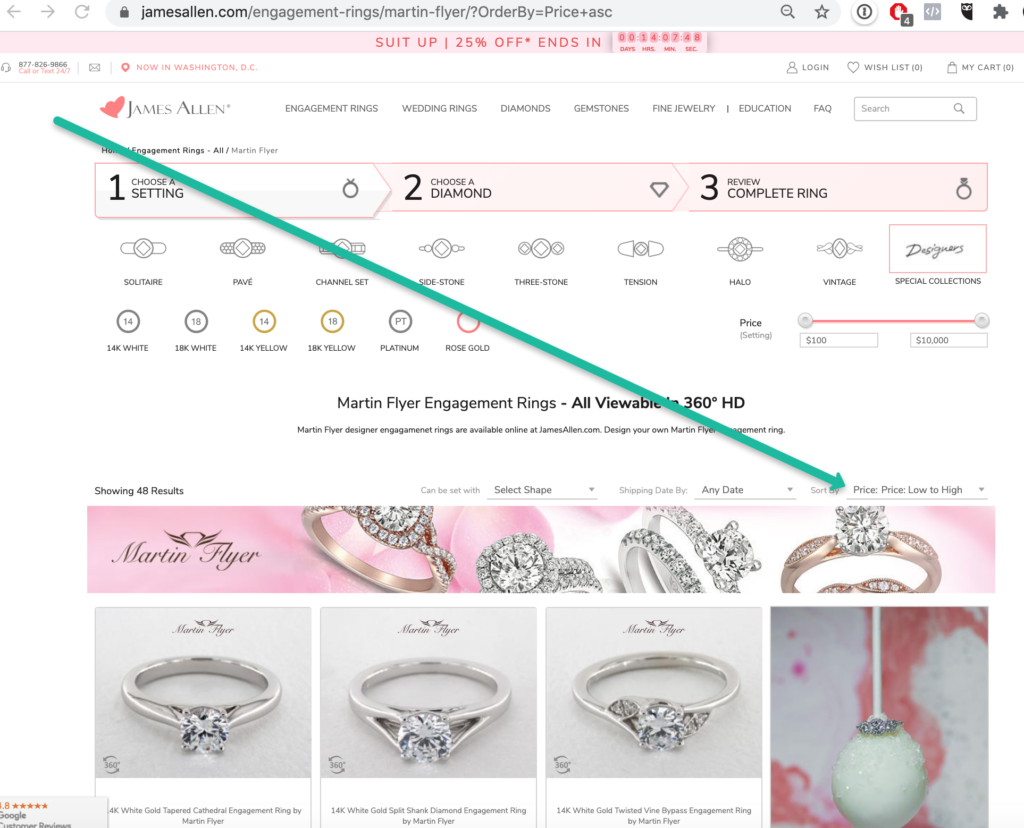
Are James Allen’s diamond prices representative?
James Allen’s diamond pricing is generally the lowest of the few highly-reputable online diamond retailers. For example, you’d pay probably 60% more at Tiffany & Co. for an equivalent diamond, in my experience.
But don’t take my word for it: Cross shop similar diamonds at James Allen, Blue Nile and Brilliant Earth, three of the leading online diamond jewelers.
If you really want a shock, walk into a chain brick-and-mortar jewelry store and ask to see an exactly comparable diamond. It will cost significantly more, I’m willing to bet on it!
Guide to where to buy diamonds
Our diamond buying guide wouldn’t be complete without looking at the four main places you can buy a diamond: Brick-and-mortar jewelry stores, diamond wholesalers, verified online sellers and unverified online sellers (e.g. eBay).
Brick-and-mortar jewelers
Before the internet, there were only two ways to buy a diamond: Walk into your local jewelry store or find a diamond wholesaler (which usually meant a trek to the New York City diamond district).
Buying from a brick-and-mortar jeweler has some advantages. The major disadvantage is that you’ll pay much more.
Pros
- You can see a diamond in-person before buying it. You can hold it, too.
- You can ask questions of a salesperson face-to-face.
- Immediacy: You can walk out of the store with your diamond engagement ring in your pocket.
- If you buy from a local, independent jeweler, you can support a local business.
Cons
- You have a very small inventory to choose from.
- You can look at each diamond only in real time, for a few seconds. You have to keep going back to the store if you want a second look.
- You can’t easily compare the pricing of multiple gems of different sizes or qualities.
- You can’t easily (or politely) comparison shop one jeweler’s diamonds against another.
- You may feel some pressure from the salesperson.
- And, the big one, you’ll pay between 50% and 100% more.
At the end of the day, you may well decide that paying more is worth it to see and touch your diamond before buying it and interact with a real person.
Take some advice form someone who has bought diamonds in all of these different ways: Buy from a local independent jeweler, not a big chain store.
The big jewelry chains might seem to offer lower prices, but that’s almost always because you’re getting a lower-quality diamond. And, if you ever have any problems with your purchase, you’re almost certainly going to get better service from your local jeweler.
Diamond wholesalers / NYC diamond district
The New York City diamond district, located on West 47th street between 5th and 6th avenues, is the United States’ largest concentration of diamond wholesalers. Similar, but smaller, jewelry districts exist in many American cities including Los Angeles, Chicago and Philadelphia.
In addition to providing wholesale diamond supply to retail jewelry stores, shops in these districts are happy to sell directly to consumers.
Pros
- Most of the pros of buying from a local brick-and-mortar retailer, listed above, also apply.
- You can see much more inventory and a more easily comparison shop because there are many shops on the same block.
- It’s possible to get a good price, but you must be a shrewd negotiator. (You’ll be buying from someone who haggles over diamond prices all day, everyday…you might get an incredible deal, or you might get taken.)
Cons
- This is a different shopping experience than a jewelry store. Nobody is going to offer you a cup of coffee or put your ring on a velvet pillow. There’s no emotion involved; it’s just a financial transaction — one of hundreds these stores do in a day.
- You must live in (or travel) to NYC or another city.
- You’ll pay less than a retail jeweler, but still more than a good online jeweler. (These wholesalers have to pay high city rents and other overhead.)
- You can’t easily compare more than two or three diamonds at a time, max.
- You can look at each diamond only for a few seconds, or a few minutes at most. There will be a lot of pressure — not just to buy, but also to buy quickly. These guys want to make a sale and move onto the next one.
Unverified online diamond jewelers
There are many websites that sell diamonds — from discount (low-end) jewelers to auction sites like eBay. But any site that doesn’t provide detailed diamond images, grading reports and bulletproof satisfaction and return guarantees is a risk.
Pros
- You have the convenience of buying online.
Cons
- You are buying blind, without actual images of the diamonds, and without diamond grading reports from the GIA, IGI, or AGS.
- Even if you see a “diamond certificate”, it’s mostly useless unless it’s a diamond grading report from one of the three labs mentioned above.
- You simply can’t be sure what you’re buying, and being ripped-off is a real possibility.
Verified online diamond jewelers
Verified online jewelers like James Allen, Blue Nile and Brilliant Earth sell thousands of diamonds online, everyday. It’s all they do, and they’ve perfected it. They bend over backwards to give you confidence in your purchase — from 3D diamond images to official grading reports.
Pros
- You can see and compare many, many diamonds at once.
- You know exactly what you’re buying, because you can see magnified 3D images of it. And you can get access to the diamond grading report from an unbiased, 3rd-party lab — the GIA, AGS, or IGI.
- You get the lowest prices, because of their business model. (They have dramatically lower expenses than brick and mortar businesses.)
- You have immediate searchable access to over 100,000 diamonds at a single store, in most cases. The inventory is practically endless.
- You can search instantly via an entire set of filters for color, clarity, carat weight, cut quality, shape, cost, and more. This is simply invaluable. And it’s simply impossible with any other category of store in this list.
- Some (Such as Brilliant Earth and Blue Nile) also have showrooms. (Personally I don’t consider this a “pro” for me, because I only like online shopping, even for groceries. But I know that some people do like showrooms.)
- You enjoy a 30-day no-questions-asked 100% money-back guarantee at Brilliant Earth, James Allen or Blue Nile.
Cons
- You can’t see and hold your diamond in-person before buying.
- You’ll have to wait up to a few days for your ring.
- You can’t “go shopping” with your partner in a beautiful showroom.
Diamond buying guide: How to build and buy an engagement ring online
It’s no surprise we think online jewelers like James Allen, Blue Nile and Brilliant Earth are the best places to buy a diamond. I’m biased, but I think you’ll ultimately agree!
As awesome (and easy) and the experience has been for me, I remember when the idea of buying a diamond online seemed odd. Or difficult.
Shopping for a diamond online isn’t difficult at all. Here, I’ll give you a quick walk-through of the diamond buying process online. You’ll learn some tricks that you might not discover right away. Tricks of using the search tools to pull up the most incredible values.
Here’s a process you can follow at any such retailer. I’m using James Allen for demonstration because it’s the site I’m most comfortable with, but the other two sites (Brilliant Earth and Blue Nile) work similarly.
Before you begin, prepare to be sold
You’re about to enter a sales arena in which copywriters, salespeople, and marketers play to win every day. You shop for an engagement ring once in a lifetime (if you’re lucky).
If you’ve ever bought a car, you know that you have to be prepared for the car salesperson’s often aggressive sales techniques.
Although you may not be walking into a jewelry store and talking face-to-face with a salesperson, make no mistake, these websites are going to try to sell you!
So you have to resolve before you go into the arena to not fall for very motivating tricks of language and sales psychology.
I suggest literally writing these rules on a Post-It note or other paper, so you’ll remember them and commit to them.
- Don’t purchase any diamond which doesn’t have a 3D image online.
- Don’t purchase any diamond which doesn’t have a diamond grading report from the GIA, AGS, or IGI.
- Build your own ring. Don’t buy one that is pre-made with a preselected diamond.
- Don’t get distracted by ads or fall for “hurry-up” sales.
Some settings sometimes go on sale for significant discounts. But diamonds rarely go on sale. No matter what the “markdowns” may say. Write this rule twice.
Avoiding fake diamonds
As long as you stick with a reputable jeweler, the chances of being sold a fake diamond are quite small. These jewelers (and the diamond industry as a whole) simple has too much at stake to allow counterfeit diamonds anywhere near their inventory.
That said, there are plenty of inexpensive yet convincing diamond alternatives out there like cubic zirconia and moissanite. These stones are worth a tiny fraction of a real diamond’s value, so it’s not inconceivable that scammers might try to pass one off as the real thing. So beware sketchy sellers or any deal that seems too good to be true.
There are several ways to tell a whether a diamond is real or fake and not all of them require specialized expertise or expensive equipment.
Now that you’ve put those rules around you, you’re ready for the fun.
Step 1: Set a budget
There are no hard and fast rules for how much to spend on an engagement ring, despite what marketers say.
That old line “you should spend a month’s salary on an engagement ring” (or was it two months’ salary!?) was invented by a diamond company. It was an ad campaign! So, yeah, through that right out the window.
Spend what you want. Just don’t spend more than you can afford. Remember that a diamond is not an investment. If you can’t pay for your diamond all at once, don’t buy something that will take you more than a few months to pay off!
Of course, your goal is to find a diamond engagement ring that you and your future spouse will be happy with — for a lifetime, if possible. If you can afford it, there are arguments for splurging here.
If you’re working with a small budget, that’s fine! Many couples upgrade their ring years down the road.
(Remember, James Allen has a lifetime 100% upgrade guarantee. They’ll credit you 100% of the value of a diamond you purchased from them if, at any time in the future, you want to trade it in on a diamond worth at least twice as much.)
Step 2: Start with a setting
The setting can be equally as important as the diamond. More than anything, it defines the aesthetic of your ring and may influence your choice of diamond shape.
If you want to showcase the diamond, then getting a very plain, inexpensive setting is fine. If you want to set off the diamond with other diamonds, or other gemstones, or decorative metalwork in the ring, then you’ll choose a more elaborate, more expensive setting.
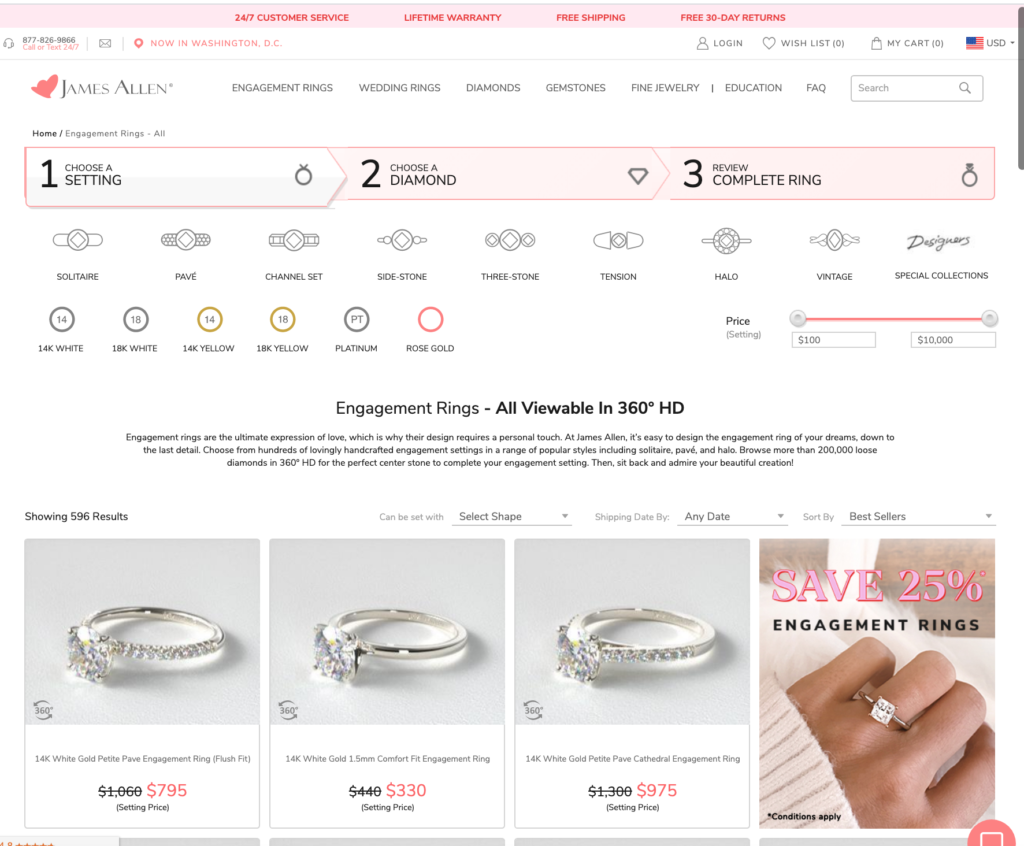
There are two strategies for budgeting for a setting (the ring itself).
Solitaire diamond settings
Choosing the least expensive setting you can find can actually maximize the attention on a solitaire diamond. If this is your strategy, then your tactics are easy: Simply go to James Allen’s settings page and sort by price. Look for the 14K Gold setting which is the least expensive.
14K Gold is the most common setting in the world. The reason is that it’s a hugely solid metal for engagement rings. It’s beautiful. (Unlike 10K gold which can seem drab compared to 14K or 18K.)
14K Gold is also hard enough to stand up to daily use. (Unlike 18K gold which hardly looks better but which is much softer.)
And 14K Gold is always easily resizable, repairable, and fixable. (Gold is very malleable, and the skills for working it are widespread. Some metals such as Palladium are much harder to work on, if not sometimes impossible.)
Yellow gold is easier to maintain than White gold, which requires a Rhodium plating. The Rhodium plating must be redone every couple of years, at least. That costs $60 to $100.
The least expensive setting, a classic, and perfectly acceptable to everyone, is a 14K gold solitaire engagement ring setting.
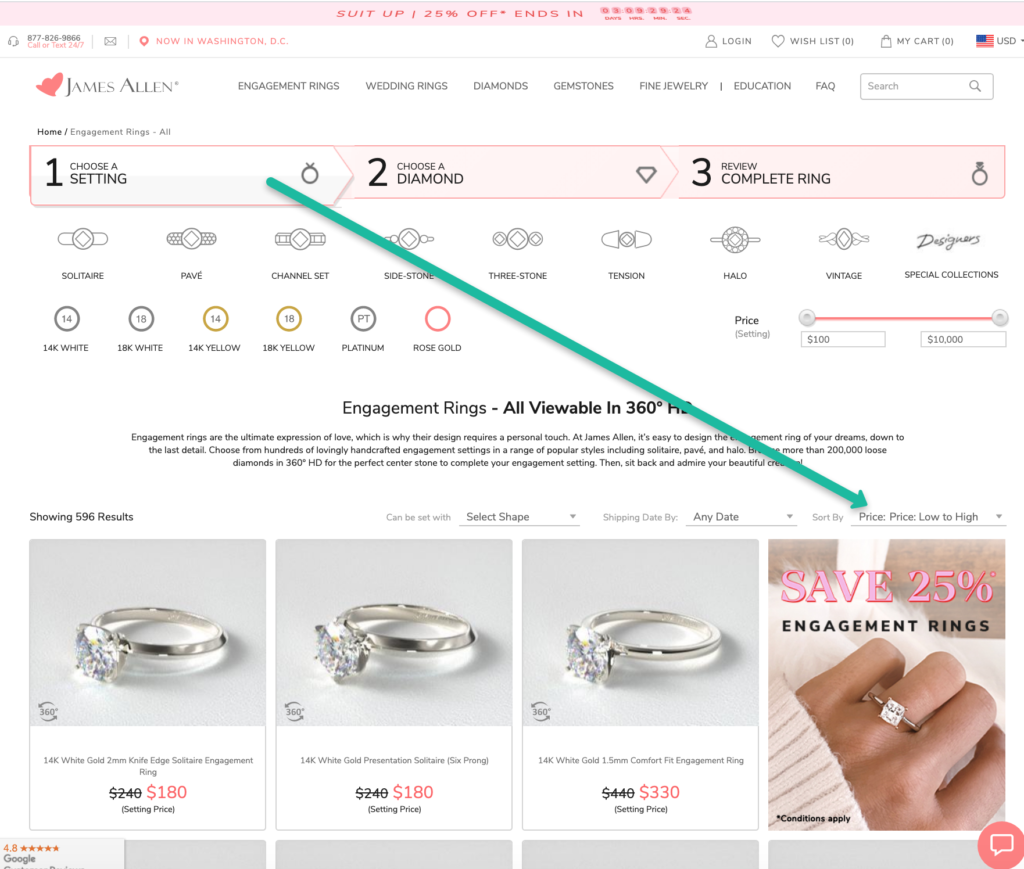
Pavé, side-stone and other decorative settings
There are many beautiful settings that incorporate additional diamonds and/or more design elements than a simple solitaire setting.
Keep in mind that you can choose from a huge variety. Sort and filter through the jeweler’s selection using the filters indicated by green arrows in the image below. (Shown as James Allen’s site, but Brilliant Earth and Blue Nile have similar filters.)
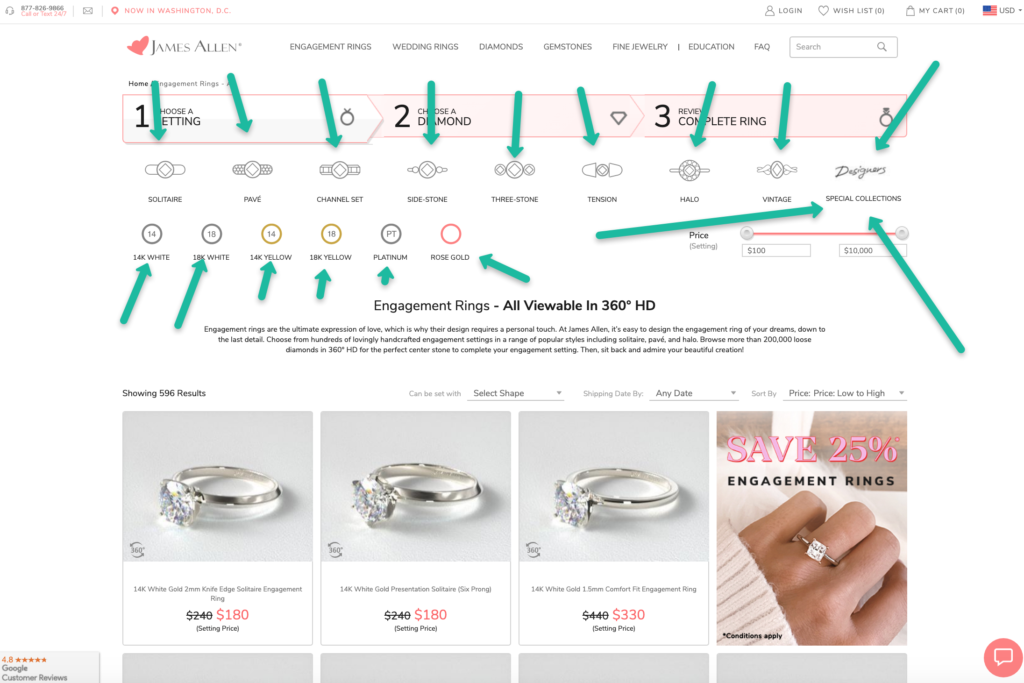
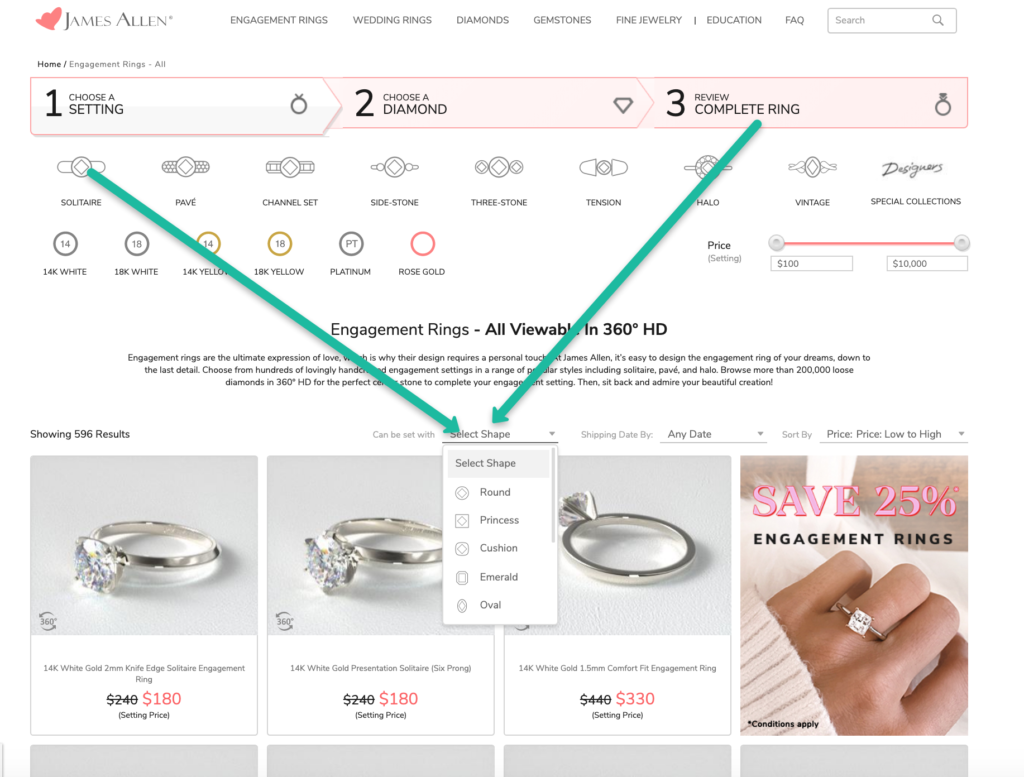
As you look at settings, “save” your favorite ones to narrow down later.
If you’re like most people, you may not settle on a specific setting just yet. That’s true especially if you’re not going for the least expensive one. (In that case your decision is easy. But if not …) You’ll want to “save” ones that you’re interested in.
So be sure to use the “heart” icon, not the “select this setting” button. Using the heart icon (while logged in to your James Allen account) will save it in a “wish list” which functions like a “favorites” list which you can easily refer to.
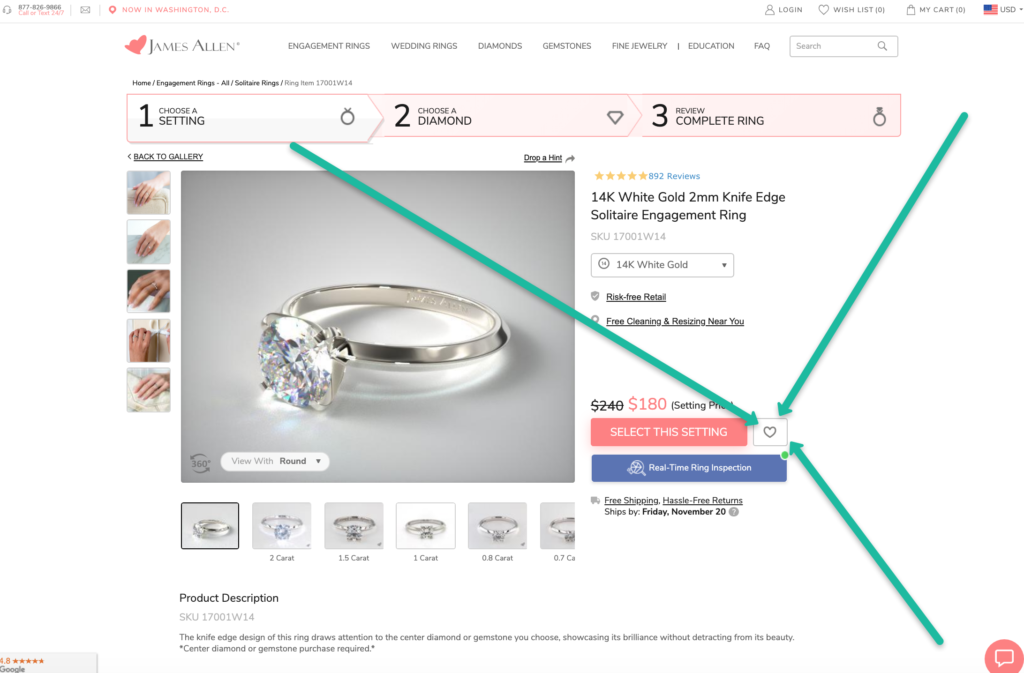
Now it’s time to move on to the main event: the diamond.
Step 3: Choose a diamond
When choosing a diamond, it’s important to not go in with any set-in-stone preconceived notions of what clarity grade, color grade, carat weight, or cut quality you want. Your vision will clarify soon, as you go through this process.
It’s better to go in with a budget (you’ve already set that) and with a general idea of what you want.
You’ll be able to narrow it down later. Especially you’ll be able to stay within your budget by making trade offs in certain qualities against other qualities. You’ll be able to find a diamond that you love.
Let’s begin.
A. Choose a shape
First choose a shape. It’s the most important choice because it affects everything. Most people choose a round brilliant cut shape for a reason: it’s hands down the most brilliant. It has the most sparkle. The most fire.
But page through the shapes, using the filter. Feel how you feel about them. Notice what you like. Notice what you think your future spouse would like.
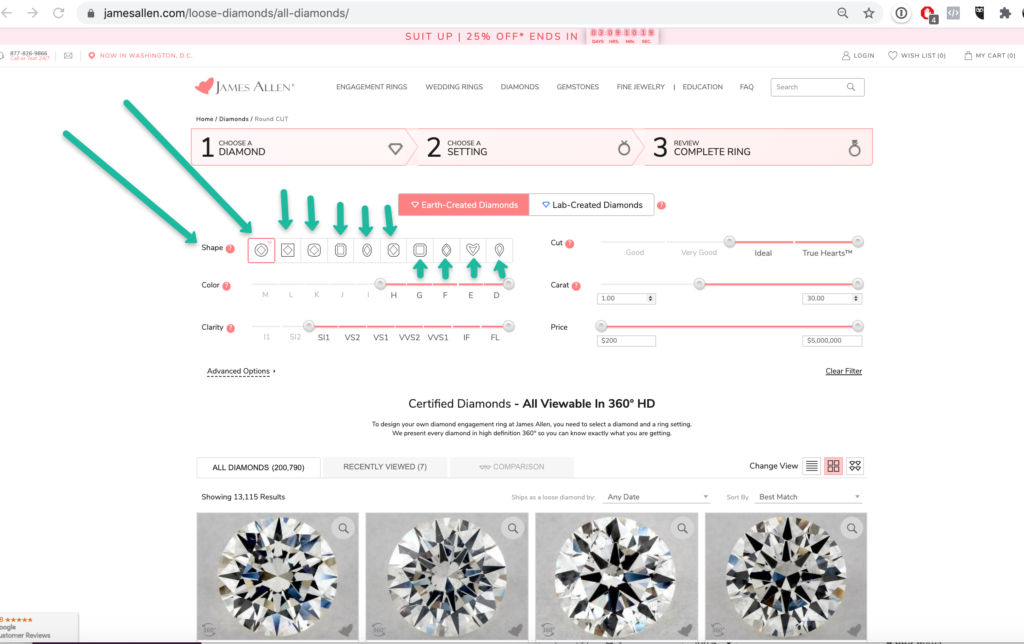
B. Play with the sliders to narrow your choices
First, set your budget slider.
You can do that by typing directly into the upper budget field (see the arrow below). Or by dragging the slider.
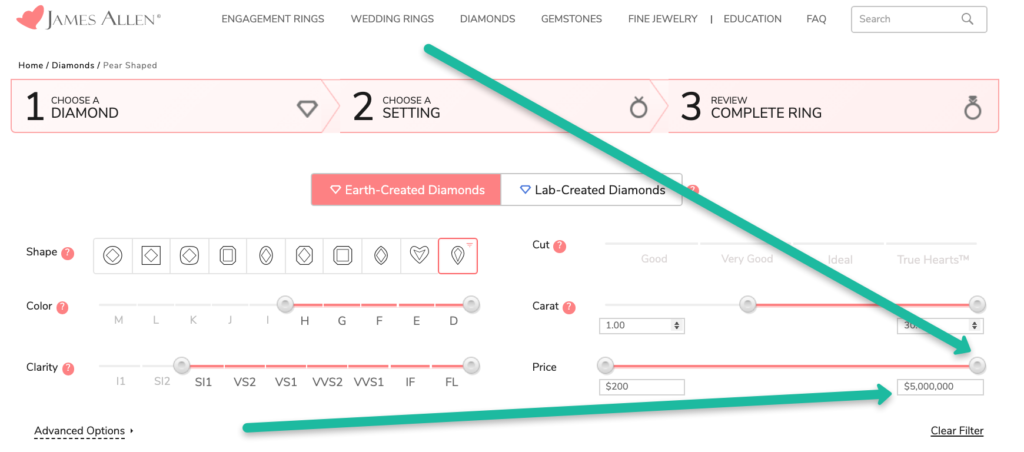
Next, adjust the other sliders, and look at individual diamonds in great detail, as you do. This is the most enjoyable, and slightly stressful, part of the entire process. It’s an exploration. Enjoy it.
Notice how the diamond’s appearances change as you play with the various sliders and look at the individual results.
To keep costs down, in general, it’s best to choose VSI Clarity, then examine individual diamonds to find one which is “eye clean.”
That means the inclusions (flaws) aren not easily visible from the top. Of course, using the huge magnification of the 3D images, you’ll be able to see inclusions online which you probably can’t see with the naked eye. So keep that in mind.
C. Save diamonds that interest you into your “wish list”
As you shop, and sort, and explore hundreds of diamonds (isn’t online shopping incredible?), you will see some that you want to keep track of.
Just save them into your wish list. Use the “heart” icon on the individual diamond page.
After a couple of days of shopping, and after discussion with trusted friends (or with your future spouse if it’s not a surprise), you’ll have a few diamonds in your wish list that you’re truly interested in.
D. Comparison shop at Blue Nile and Brilliant Earth by searching for diamonds with the same grades (optional)
If you want to be completely systematic, comparison shop at Blue Nile and Brilliant Earth.
Some reasons you may want to:
- You may find a diamond at Brilliant Earth or at Blue Nile which you like better
- You may (it’s possible but I never truly expect it) find a lower price on a diamond with very similar grades across the 4Cs.
However — and this is always subject to change — in general, James Allen has the lowest prices.
That doesn’t mean James Allen must be your first choice. You may find a comparable diamond at the other two retailers for more money, but you may just like it better. Or you may have other reasons. Brilliant Earth, for example, takes pride in their dedication to selling only responsibly-sourced jewelry.
E. Remember, follow the rules you set out for yourself at the beginning
Remember those rules at the beginning? Review them now. You’ve been in the company of highly skilled marketers.
You’ve been bombarded with ads from Google, and on social media.
Make sure that you haven’t begun to break any of the safety rules you set out for yourself at the beginning.
F. Sleep on it
A diamond is a huge purchase. It’s not just the money. It’s an immensely important choice of gift. So it deserves some thought. Some time given to it.
Talk it over with anyone who is sensible, and who you can trust to give thoughtful opinions.
But do NOT talk it over with her mom, or her friends, her cousin, etc. That’s my opinion, obviously. But here’s why I suggest it:
She’s counting on you to make the decision. If you talk it over with her mom, that will get back to her — after the engagement if not before.
It’s not the end of the world. It’s not a terrible mistake.
But if you can make the decision using resources in your world, on your own, and not depend on simply asking someone, she’ll appreciate it more, is my belief.
Nothing’s true for every couple, obviously. But I think that’s a good general rule.
If you need to find out her ring size, get a metal finger gauge from Amazon, and use it to check the sizes of rings she wears. Think like James Bond. You’ll find an answer.
Step 4: Build ‘the ring’ using the setting and the diamond you chose
Now that you’ve decided, it’s time to put the ring and the setting together.
You do that by selecting “Choose this setting” on the setting page. And by choosing “Select This Diamond” on the diamond page.
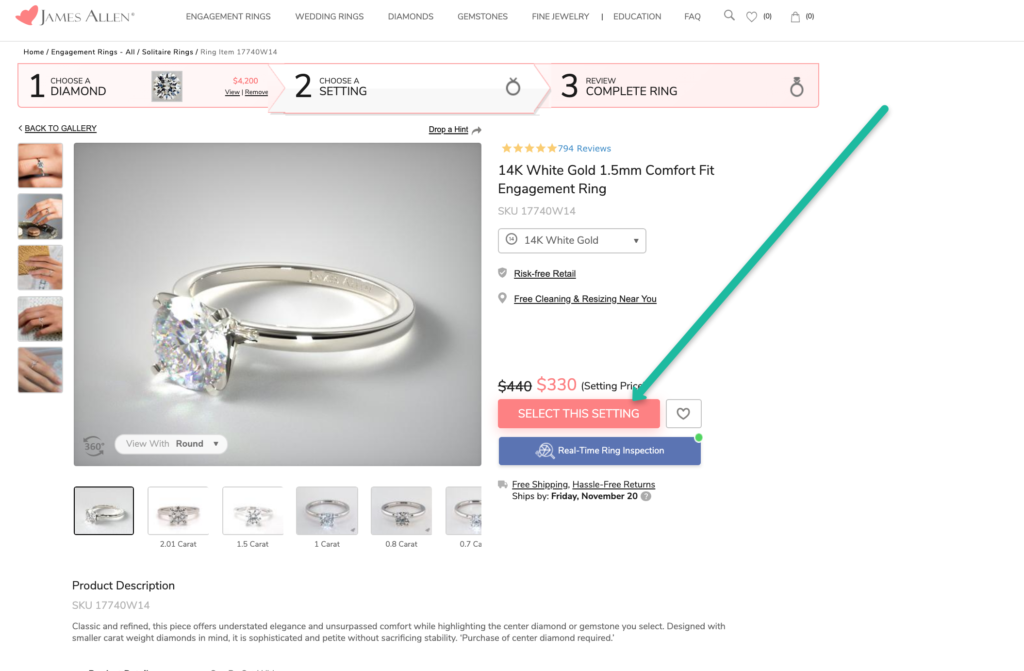
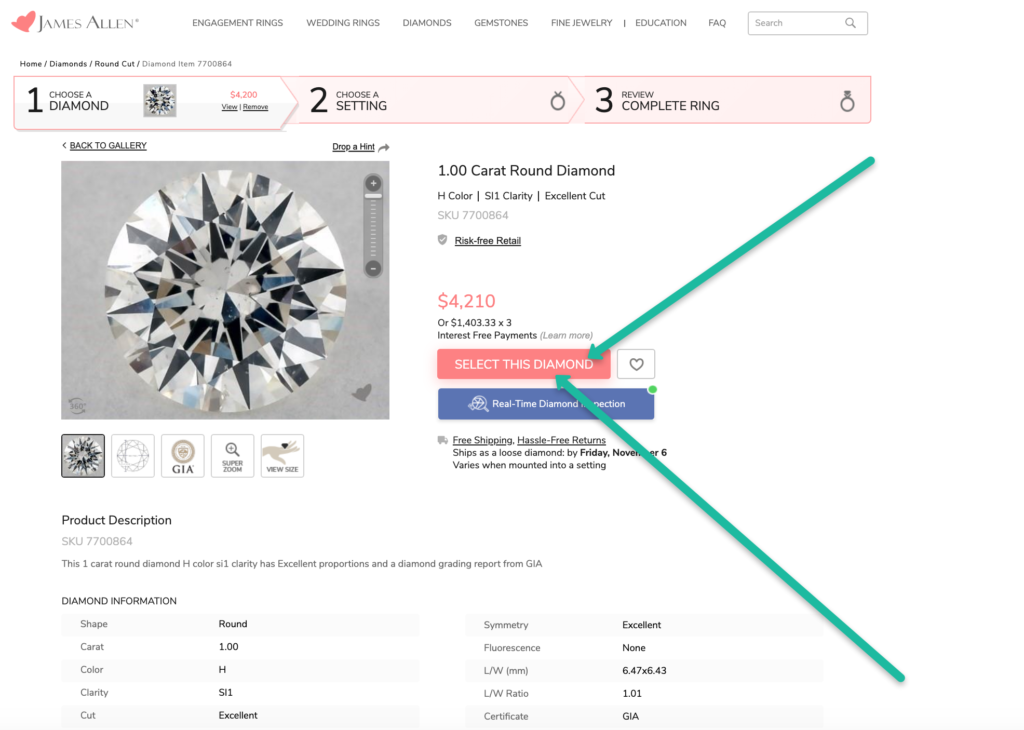
Note: If your selections seem messed up (for example, the retailer has strangely sent you to the pendants section!) it’s because you’re trying to select a diamond and setting which don’t match.
No problem. Just choose a different setting. I’ve seen this happen with Pear shaped diamonds, for example, when I had chosen a setting to which it couldn’t be mounted to.
Step 5: Make the purchase
This is easy, but it’s fun. So I gave it a step all to itself. Yes, it will feel great. And you might feel a little nervous. Here’s how to feel perfectly confident: remember the return guarantees.
No problem. Remember, James Allen, Brilliant Earth, and Blue Nile all give you the ability to return it if you decide you need to, within 30 days.
Step 6: Purchase a jeweler’s loupe at the same time from Amazon
You’ll want to be able to examine your diamond ring when it arrives. So order the loupe now. It should arrive before the ring.
Step 7: Compare the diamond in the jeweler’s loupe with the diamond’s 3D imaging
When the ring arrives, enjoy and celebrate quietly, alone. And definitely look at it closely with a jeweler’s loupe, to enjoy the full beauty of it.
Compare the ring to what is described in the GIA, IGI, or AGS diamond grading report which comes with it.
You can trust all the retailers I link too, 100%. But any company anywhere can make a mistake. It’s your responsibility to follow up by examining the gem closely yourself. If you have any questions, call the retailer. They’ll straighten things out for you.
Also check the size of the ring using the metal finger gauge that you ordered from Amazon earlier in this article. Just to make sure it’s the size that you ordered.
Again, of course the retailers I link to are 100% trustworthy. But anyone can make a mistake. The purchase is among the most important in your life. So it only makes sense to verify with your own eyes that it’s what you ordered.
Congratulations!
You just bought a one-of-a-kind diamond engagement ring or other piece of jewelry using our diamond buying guide.
I hope you’ll enjoy your purchase for a lifetime. (And I think you will!)
If you have questions about the diamond buying process that this diamond buying guide didn’t answer, please let me know at editor@diamondbuyingschool.com. My goal is to make this page the only resource you need to buy a diamond online with confidence. Your feedback will be invaluable!
Recommended Jewelers
James Allen
James Allen is the most competitive diamond vendor with more than 150,000 loose diamonds in inventory. They have been a leader in selling diamonds online and pioneered 3D imaging so you can see the exact diamond you're buying in exquisite detail. You'll find it hard to beat James Allen in terms of price or selection. Read our James Allen review. |
Whiteflash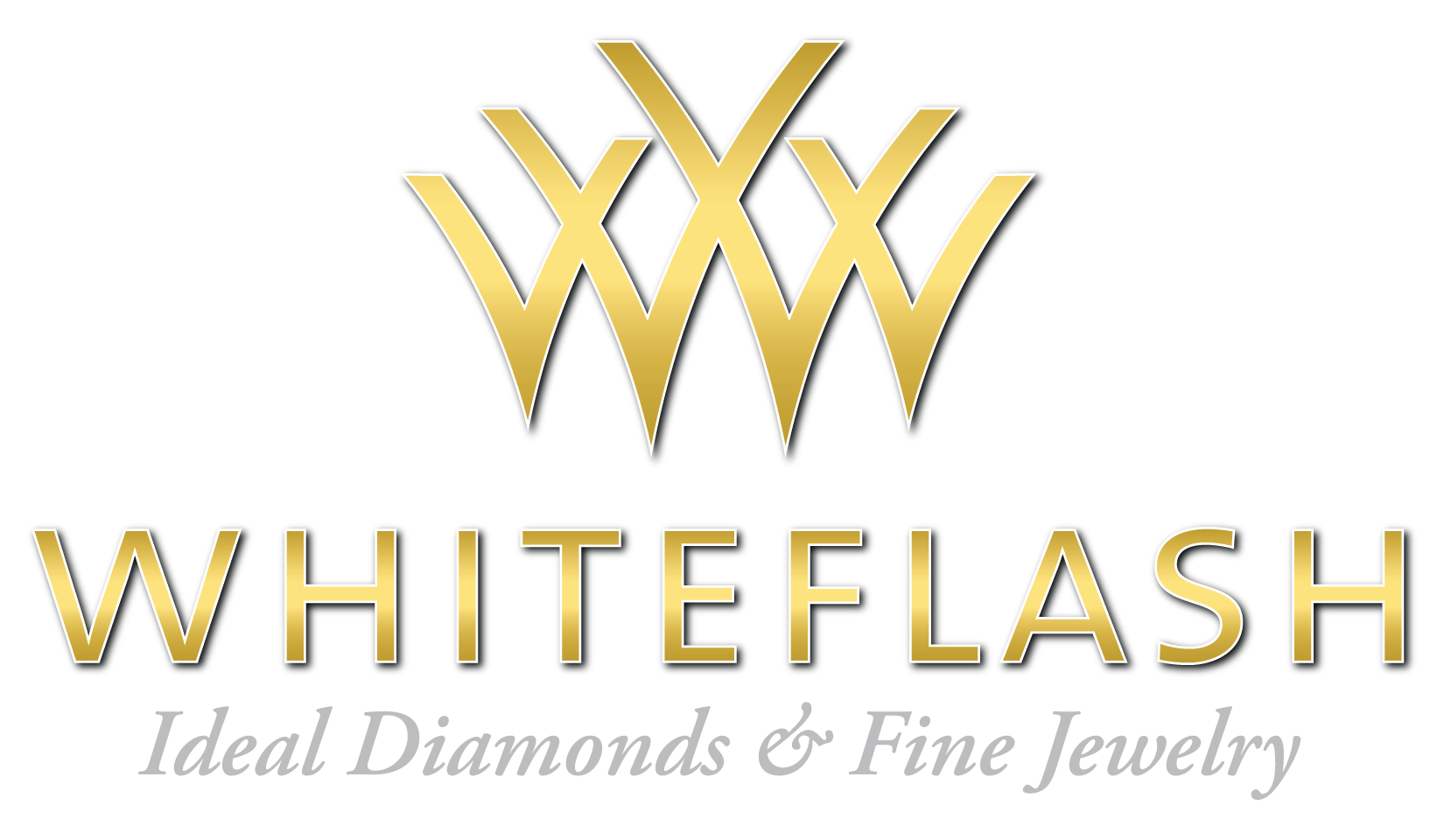
Whiteflash is the home of "A Cut Above" diamonds which are among the best quality round- and princess-cut diamonds in the world. With superior diamond photographs and videos, Whiteflash's diamonds seem to come to life -- even online. Read our Whiteflash review. Shop Whiteflash » |
Brilliant Earth
Brilliant Earth is the global leader in ethically-sourced jewelry. Brilliant Earth goes above and beyond existing standards to offer “Beyond Conflict Free Diamonds” that they select for their ethical and environmentally-responsible origins. With over 120,000 diamonds in inventory, you can be sure to find your perfect diamond and feel good knowing it was responsibly-sourced. Read our Brilliant Earth review. Shop Brilliant Earth » |
Blue Nile
Blue Nile is the world's largest online jeweler. Their reputation for quality and customer service is unparalleled in the industry. Blue Nile offers free shipping, a 30-day return policy and satisfaction guarantee. Read our Blue Nile review. Shop Blue Nile » |
